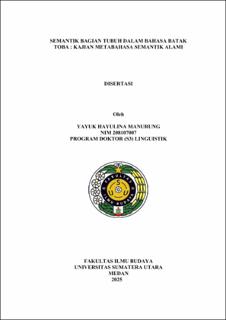| dc.description.abstract | The human body is an evident domain for exploring shared universal meanings. However, cross-linguistic investigations reveal significant variations in the extension of human body part terminology, as not all languages categorize the body in the same way. Batak Toba Language (BTL) is spoken by the Batak Toba people around Lake Toba, Samosir Island, North Sumatra, Indonesia. This study examines the semantics of body parts in BTL through the framework of Natural Semantic Metalanguage (NSM) as proposed by Wierzbicka (2007). The objectives of this research are to categorize body parts, analyse and introduce new lexical entries to fill gaps in body part nomenclature, detail the meanings of body part terms, and formulate the semantic typology of body parts in BTL and cross-linguistically. This study employs a qualitative approach, generating descriptive data in the form of written and spoken words from informants, as well as lexical data of body part terms in BTL as spoken by native speakers residing on Samosir Island. Data collection techniques include observation, interviews, and questionnaires. The findings categorize body parts in BTL into three groups: upper body parts, middle body parts, and lower body parts. In body part nomenclature, at least three semantic components are identified: location, shape, and function. Interestingly, no specific term for the Adam's apple exists in BTL. Additionally, the term hurum refers to three distinct body parts-jaw, cheek, and temple while sihotingon refers to both the hip and waist. In the semantic interpretation of body parts, meaning analysis aligns with the origin of body part nomenclature, reflecting seven principles governing cross-linguistic body part organization: (1) Body Universality, (2) Partonomy, (3) Duality, (4) Hierarchy, (5) Topography, (6) Internal Logic, and (7) Orientation. Furthermore, the semantic typology of body parts in BTL and other languages demonstrates similarities in the application of the partonomic principle, consistent with Brown's (2015) theory, as well as the positioning of the face as a reference and viewpoint in spatial concepts. However, sociocultural influences create unique categorizations, leading to considerable variation in semantic extension and referential scope. | en_US |


